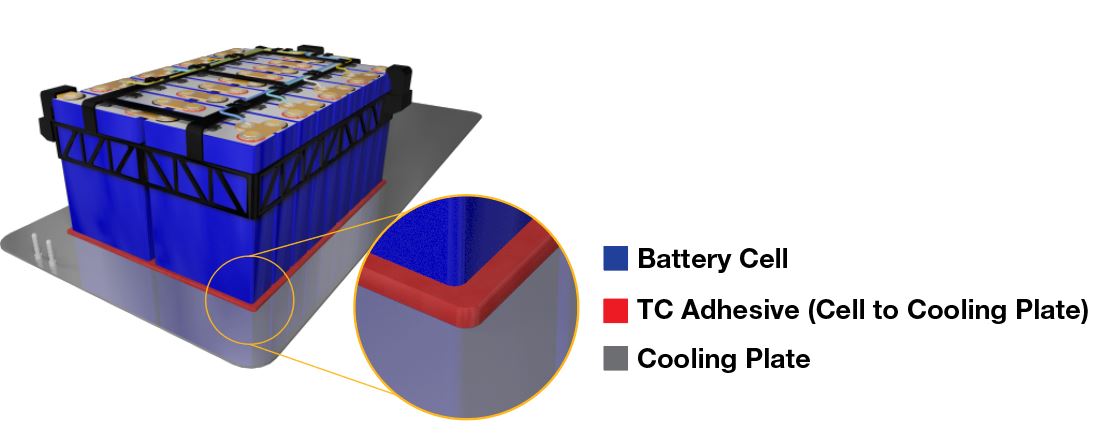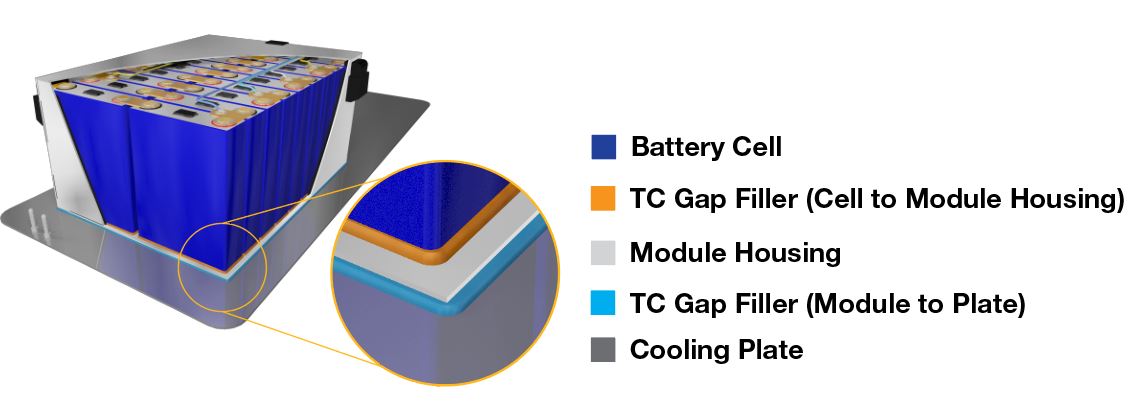>> Contact GFS for application or engineering guidance for battery sealing applications >>
With the significant growth and development of battery pack technologies, manufacturers of Electric Vehicles (EVs) are placing an increased emphasis on optimizing pack design. Manufacturers seek lighter weight, yet more compact solutions to gain additional energy density. At the same time, they are also striving for simplicity and affordability. To achieve these goals, manufacturers are looking at both immediate and long-term solutions. These solutions include bonding individual cells directly to the cooling plate and bonding directly to the vehicle chassis. For these solutions to be viable, new thermally conductive (TC) adhesive technology is necessary. As a leading supplier of thermal management encapsulants, adhesives, and gap fillers, we are developing TC urethane adhesives that will enable the direct bonding of battery cells with cooling plates.
Parker's team of experts has produced a white paper where we explain these new developments in TC urethane adhesives compared to traditional battery pack configurations and associated adhesive solutions. In this first part of Parker's blog series summarizing the white paper’s key points, we will review the current battery pack configuration, the next generation cell-to-pack (CTP) configuration, and the formulation, development, and testing processes. The second part of this series will provide the results, insights, and what it all means for battery and EV manufacturers.
Current battery pack configuration
Thanks to highly stringent safety standards and affordable, abundant supply chains, most EV manufacturers have adopted standard battery configurations. This current configuration consists of numerous battery modules, each containing groups of individual battery cells. This approach enables control, monitoring, and the ability to service discrete battery modules. Additionally, the current configuration provides additional crash and environmental protection. While also incorporating greater electrical isolation between and around modules, this configuration helps prevent fire propagation.
The current configuration involves a minimum of two discrete thermal interface materials (TIMs), also known as “gap fillers” (GFs), which, with the aid of a liquid-cooling plate, help regulate the modules’ temperatures to ensure safe and efficient performance. The Cell-to-Module (CTM), or upper gap filler, fills in the spaces between the lower sides of individual batteries and the gaps between the bottom of the batteries and the module housing’s inside wall. The CTM is often based on chemistries, such as urethanes, that offer strong adhesion and great flexibility.
The second TIM is the Module-to-Pack (MTP), or lower gap filler. This TIM fills in large spaces between the cell modules and the large cooling plate for the entire battery pack. Like the CTM, the MTP also provides heat conduction. However, the MTP is designed to lightly adhere to the cooling plate surface and enable easy removal of discrete modules for servicing.
The MTP gap filler is typically based on compliant chemical backbones like silicone or soft urethanes. Parker LORD’s CoolTherm® product line includes thermal management materials designed for CTM, MTP, and ancillary EV and electronics applications.
Next-generation cell-to-pack configuration
While the current modular design has its benefits, it also has its challenges. The module’s inactive portions add weight, occupy precious volume, and cause compromised pack energy density. In addition, with many discrete parts, the design, manufacturing, and supply chain logistics are more complex. As a result, many EV and battery manufacturers are eliminating the modulus and bonding batteries directly to the cooling plate. This new approach, called cell-to-pack (CTP), increases volume-utilization space, reduces the number of parts, improves pack energy density, and gives EV manufacturers the option to use less expensive and lower energy density cells.
In addition to reducing by half the number of thermal interface materials and interfaces and eliminating module housing, the CTP also significantly lowers the thermal resistance of the stack. This offers reduced cooling or heating loads by the cooling plate and enables the application of lower conductivity gap fillers.

However, this change has led to more stringent environmental requirements because the module housing is no longer in place to protect the batteries from the environment. For example, OEMs now require thermally conductive adhesives to ensure strong, flexible bonds between the battery cells and the cooling plates. In response to the growing adoption of CTPs and the associated requirements, we are developing new adhesive technologies, including thermally conductive CTP urethane adhesives.
Putting urethanes to the test
Urethane chemistry, in two-part form, offers a good balance of strength, ductility, and formulation versatility. For the test, we developed two types of two-part TC urethanes based on traditional chemistries designed for CTM applications and new chemistries for CTP applications. Afterward, we performed lap shear adhesion tests according to ASTM D1002 on aluminum and PET film used in commercial EV applications. In addition to the adhesion tests, we measured bulk properties, including viscosity, thermal conductivity, ultimate tensile strength, elongation at break, and dielectric constant, according to their respective ASTM or ISO standard test method. The results? Impressive! For more on the results of Parker's testing, check back for the second part of this series coming soon.

